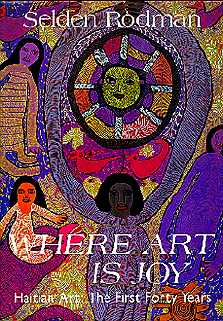|
Where art is joy : Haitian
art, the first forty years / Selden [Cary] Rodman. - New
York : Ruggles de Latour, 1988. - 236 p. :
ill. ; 31 cm.
ISBN 0-938291-01-7
|
JEAN
KENNEDY :
[…]
Rodman,
who has written about Haiti for many years, has now completed the most
comprehensive work to date on the art of that island. His text
documents the rise of modern Haitian art in, for the most part,
chronological fashion. (…) This publication recounts the
history
of this period in more detail, as it includes descriptions of major
works by seventy-six individuals, accompanied by stories of Rodman's
personal encounters with a number of them.
[…]
☐ African Arts, 24/1,
Jan. 1991 [en
ligne]
| ❙ | Selden
Rodman (1909-2002) was a prolific and versatile writer of poetry, plays
and prose, political commentary, art criticism, Latin American and
Caribbean history, biography, and travel writing. — source : Archives at Yale [en ligne] |
|
| EXCERPT |
From its
beginning in the mid-forties with the discovery of Hector Hyppolite and
Philome Obin, to its fourth flowering in 1987 with the painters of
Saint-Soleil becoming dominant, Haitian art has been consistently
surprising : a wonder of the world.
In no other
country has a school of self-taught painters and sculptors reigned
supreme, renewing itself year after year. Not even in Africa have black
artists created so many unforgettable images to haunt and revivify the
tired iconography of the West. How to explain the paradox that an art
of joy originated and sustains itself in the poorest nation of the
Western Hemisphere ? A blend of African and French cultures,
inspired by both the Vodou and Christian religions, Haitian life has a
unique quality, timeless yet electric. Close to nature, close to his
family, close to his gods, the Haitian farmer still leads a life little
influenced by the fashions and the inventions of the twentieth century.
Some of
Haiti's greatest artists, Hector Hyppolite, Andre Pierre, and Lafortune
Felix were first houngans (vodou priests). All of the Saint-Soleil
artists, first hailed by André Malraux in 1977, say they are
in constant contact with the loas (African Spirits), as was their
progenitor, Robert St. Brice. The dark side of the religion, so well
captured by the macabre images of Enguerrand Gourgue and Edgar
Jean-Baptiste, is a force every Haitian must reckon with.
The
simplicity of everyday life, transformed into poetry by Philome Obin
and the Cap-Haitian school, gives to each Haitian a sense of place in
this world just as the Vodou religion assures him a place in the
cosmos. Ongoing life that neglects neither the body nor the
spirit … that is the joy of Haitian art.
|
|
| COMPLÉMENT
BIBLIOGRAPHIQUE |
- « Renaissance
in Haiti : popular painters in the Black
Republic »,
New York : Pellegrini & Cudahy, 1948
- « The
miracle of Haitian art », New York :
Doubleday, 1974
- «
Haitian art : the third generation, with an overlook at the first
and second » catalogue of an exhibition held May
18–June 28, 1979 at the Lockwood-Mathhews Mansion Museum in
Norwalk (Ct.), Norwalk (Ct.), : Mind Inc. 1980
- « Where
art is joy : forty years of Haitian art » with Candice
Russell » catalogue of an exhibition held March 10-May 28, 1989
at the Museum of Art in Fort Lauderdale (Florida)
|
- Gérald Alexis, « Peintres haïtiens », Paris : Cercle d'art, 2001
- Philippe Bécoulet, « La peinture haitienne : dialogue du réel et de l'imaginaire », Strasbourg : Association franco-haïtienne pour la promotion des arts et de la culture, 1990
- Carlo A.
Célius, « Langage plastique et
énonciation identitaire : l'invention de l'art
haïtien », Sainte Foy
(Québec) : Les Presses de l'université
Laval (InterCultures), 2007
- [Comité Hector Hyppolite], « Hector Hyppolite », Paris : Ed. de Capri, Musée du Louvre, 2011
- Jean-Marie Drot (éd.), « An encounter between two worlds, as seen by Haitian artists », Paris : Fondation Afrique en créations, Rome : Carte Segrete, v. 1992
- Michèle Grandjean, « Artistes en Haïti : cent parmi d'autres », Marseille : Association Art et cœur, 1997
- Ernst Jean-Pierre, « Le voyage d'un peintre haïtien en Bretagne », Rennes : Ouest France, 2005
- Jean-Robert Léonidas, « Rêver d'Haïti en couleurs = Colorful dreams of Haiti » photographies de Frantz Michaud, Montréal : CIDIHCA, 2009
- Michel-Philippe Lerebours, « Haïti et ses peintres de 1804 à 1980 : souffrances et espoirs d'un peuple », Port-au-Prince : Imprimeur II, 1989
- Martine Lusardy (dir.) « Haïti, anges et démons », Paris : Hoëbeke, 2000
|
|
|
| mise-à-jour : 30 juillet 2021 |

|
|
|
|